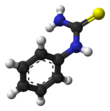| |||
| Names | |||
|---|---|---|---|
| Preferred IUPAC name
Phenylthiourea | |||
| Other names
N-Phenylthiourea
1-Phenylthiourea | |||
| Identifiers | |||
3D model (JSmol)
|
|||
| ChEBI | |||
| ChemSpider | |||
| ECHA InfoCard | 100.002.865 | ||
| MeSH | Phenylthiourea | ||
PubChem CID
|
|||
| UNII | |||
CompTox Dashboard (EPA)
|
|||
| |||
| |||
| Properties | |||
| C7H8N2S | |||
| Molar mass | 152.22 g·mol−1 | ||
| Appearance | White to slightly yellow powder | ||
| Density | 1.294 g/cm3 | ||
| Melting point | 145 to 150 °C (293 to 302 °F; 418 to 423 K) | ||
| Soluble in boiling water | |||
| Hazards | |||
| GHS labelling:[1] | |||

| |||
| Danger | |||
| H300, H317 | |||
| P280, P301+P310+P330, P302+P352 | |||
| NFPA 704 (fire diamond) | |||
| Lethal dose or concentration (LD, LC): | |||
LD50 (median dose)
|
3 mg/kg (oral, rat) | ||
Except where otherwise noted, data are given for materials in their standard state (at 25 °C [77 °F], 100 kPa).
| |||
Phenylthiocarbamide (PTC), also known as phenylthiourea (PTU), is an organosulfur thiourea containing a phenyl ring.
It has the unusual property that it either tastes very bitter or is virtually tasteless, depending on the genetic makeup of the taster. The ability to taste PTC is often treated as a dominant genetic trait, although inheritance and expression of this trait are somewhat more complex.[2][3]
PTC also inhibits melanogenesis and is used to grow transparent fish.[4]
About 70% of people can taste PTC, varying from a low of 58% for Indigenous Australians and indigenous peoples of New Guinea to 98% for indigenous peoples of the Americas.[5] One study has found that non-smokers and those not habituated to coffee or tea have a statistically higher percentage of tasting PTC than the general population.[6][7] PTC does not occur in food, but related chemicals do, and food choice can be related to a person's ability to taste PTC.[6][8]
- ^ GHS: Record of Phenylthiourea in the GESTIS Substance Database of the Institute for Occupational Safety and Health, accessed on 2021-12-22.
- ^ Guo; Reed, D. R. (2001). "The genetics of phenylthiocarbamide perception". Annals of Human Biology. 28 (2): 111–142. doi:10.1080/03014460151056310. PMC 3349222. PMID 11293722.
- ^ McDonald, John H. "PTC tasting: The Myth". Myths of Human Genetics. Retrieved 11 May 2015.
- ^ Karlsson, Johnny; von Hofsten, Jonas; Olsson, Per-Erik (2001). "Generating Transparent Zebrafish: A Refined Method to Improve Detection of Gene Expression During Embryonic Development". Marine Biotechnology. 3 (6): 522–527. doi:10.1007/s1012601-0053-4. PMID 14961324. S2CID 7980753.
- ^ Kim U, Wooding S, Ricci D, Jorde LB, Drayna D (2005). "Worldwide haplotype diversity and coding sequence variation at human bitter taste receptor loci". Human Mutation. 26 (3): 199–204. doi:10.1002/humu.20203. PMID 16086309. S2CID 31248094.
- ^ a b Fischer R, Griffin F, Kaplan AR (1963). "Taste thresholds, cigarette smoking, and food dislikes". Medicina Experimentalis. International Journal of Experimental Medicine. 9 (3): 151–67. doi:10.1159/000135346. PMID 14083335.
- ^ Kaplan AR, Glanville EV, Fischer R (1964). "Taste thresholds for bitterness and cigarette smoking". Nature. 202 (4939): 1366. Bibcode:1964Natur.202.1366K. doi:10.1038/2021366a0. PMID 14210998. S2CID 4184237.
- ^ Forrai G, Bánkövi G; Bánkövi (1984). "Taste perception for phenylthiourea and food choice—a Hungarian twin study". Acta Physiol Hung. 64 (1): 33–40. PMID 6541419.


